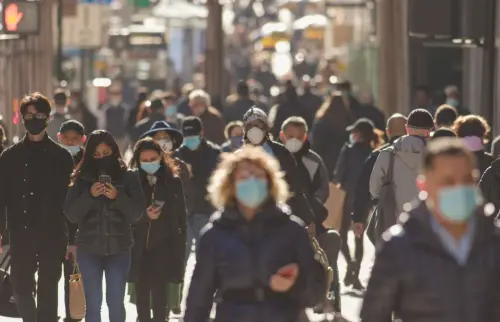Leah Korn contributed to this post.
April 7 is World Health Day, a day designated by the World Health Organization to promote health for all people across the globe. This is a serious issue facing the international community. Half of the world’s population lacks access to vital health services and over a hundred million people worldwide have been pushed into poverty due to high health care costs.
This year, World Health Day is celebrated with the slogan “Universal Health Coverage: Everyone, Everywhere.” At Brookings, experts across the institution have analyzed and highlighted aspects of health domestically and internationally.
THERE ARE 800 MILLION UNDERNOURISHED PEOPLE WORLDWIDE
As the world becomes richer, many remain hungry. The chart below displays the results of a Gallup survey asking respondents whether there were instances in the past 12 months when they did not have enough money to buy food. Even in high-income countries, around 10 percent, or 100 million people, deal with food insecurity. One of the internationally agreed upon Sustainable Development Goals aims to completely get rid of hunger by 2030. According to Homi Kharas and John McArthur, we are off track to meet this goal and, in order to see better progress, countries must have a higher sense of accountability to stick to their health and nutrition policies.

IN THE US, THE OPIOID CRISIS TAKES 175 LIVES DAILY
As a whole, the opioid epidemic takes about 33,000 American lives each year, almost matching the over 30,000 lives that gun violence and car accidents each claim yearly. The opioid epidemic has major health implications such as increased hospitalizations, substance addiction, and an increase in babies born with neonatal abstinence syndrome. The number of babies born with neonatal abstinence syndrome has quadrupled over the past 15 years. In her report, “Unburying the lead: Public health tools are the key to beating the opioid epidemic,” Dayna Bowen Matthew looks into how American policymakers can make systematic changes to fight the opioid epidemic. She encourages policymakers to look at social factors such as housing, employment, criminal justice interventions, and community engagement when looking to solve the crisis.
BOTH DEMENTIA AND TUBERCULOSIS KILL ABOUT 1.5 MILLION PEOPLE WORLDWIDE ANNUALLY
In the United States, life-threatening diseases such as dementia and Alzheimer’s receive a lot of attention, but tuberculosis, a bacterial disease that affects the lungs, kills the same amount of people globally and does not receive the same level of response. Potential treatments being developed for Alzheimer’s and dementia outnumber treatments for tuberculosis by more than three to one. Tuberculosis usually afflicts people of young ages, while dementia symptoms typically appear later in a person’s life. Dementia is the third leading cause of death in high-income countries, while tuberculosis is the fifth cause of death in low-income countries.
 Dana Goldman and Darius Lakdawalla note that the nature of dementia and tuberculosis victims plays a role in the disparity in the treatments under development. Tuberculosis does not even make the top thirteen causes of death in high-income countries, and vice-versa for Alzheimer’s/dementia in low-income countries. “It’s not that the life of a rich person matters more than that of a poor person, but the amount countries are willing to pay for treatments matter in setting development priorities,” said Dana Goldman and Darius Lakdawella.
Dana Goldman and Darius Lakdawalla note that the nature of dementia and tuberculosis victims plays a role in the disparity in the treatments under development. Tuberculosis does not even make the top thirteen causes of death in high-income countries, and vice-versa for Alzheimer’s/dementia in low-income countries. “It’s not that the life of a rich person matters more than that of a poor person, but the amount countries are willing to pay for treatments matter in setting development priorities,” said Dana Goldman and Darius Lakdawella.

$5.6 BILLION OUT OF $157 BILLION IN RESEARCH AND DEVELOPMENT FUNDS GO TO DEVELOPING COUNTRIES
In their report, “Health Governance Capacity: Enhancing Private Sector Investment in Global Health,” Darrell West, John Villasenor, and Jake Schneider unpack how low- and middle-income countries around the world effectively utilize external investment in global health research and development (R&D). The study looks at 18 countries in sub-Saharan Africa and Asia, paying close attention to their management capacity, regulatory processes, health infrastructure, policy conditions, and health systems. Vietnam, South Africa, China, and Ghana ranked the highest, while Congo, Pakistan, and Nigeria ranked the lowest. Large for-profit corporations invest large sums of money in global health R&D, but only $5.6 billion out of the annual $157 billion devoted to global health R&D goes to countries in the developing world.

0.22 PERCENT OF THE US 2016 BUDGET WAS DEVOTED TO GLOBAL HEALTH
As seen in the pie chart below, the United States contributes to almost one-third of Development Assistance for Health (DAH) spending. However, this only amounts to 0.22 percent of the entire federal budget, and if President Trump’s budget request is fulfilled, it will decrease considerably. He has called for a 24 percent reduction in spending on foreign assistance for global health. Jake Schneider and Darrell West examine how cuts in U.S. global health assistance would be devastating for global health. They predict that if a 24 percent decrease comes to fruition, the global development assistance for health would drop from $39.2 to $28.8 billion, and the U.S. contribution would drop from $13.6 billion to $10 billion. These cuts would have grave consequences for the developing world and international stability as a whole.



Commentary
5 stunning facts about world health
April 6, 2018